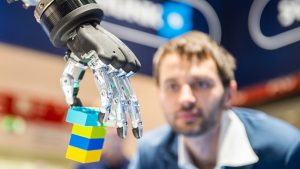Engineers at the University of California San Diego have created a four-legged soft robot that doesn’t need any electronics to work. The robot only needs a constant source of pressurized air for all its functions, including its controls and locomotion systems.
This work represents a fundamental yet significant step towards fully-autonomous, electronics-free walking robots. Applications include low-cost robotics for entertainment, such as toys, and robots that can operate in environments where electronics cannot function, such as MRI machines or mine shafts. Soft robots are of particular interest because they easily adapt to their environment and operate safely near humans.
Most soft robots are powered by pressurized air and are controlled by electronic circuits. But this approach requires complex components like circuit boards, valves, and pumps–often outside the robot’s body. These components, which constitute the robot’s brains and nervous system, are typically bulky and expensive. By contrast, this robot is controlled by a light-weight, low-cost system of pneumatic circuits, made up of tubes and soft valves, onboard the robot itself. The robot can walk on command or in response to signals it senses from the environment.
With this approach, a very complex robotic brain can be made. The focus here is to make the simplest air-powered nervous system needed to control walking.
The robot’s computational power roughly mimics mammalian reflexes that are driven by a neural response from the spine rather than the brain. The team was inspired by neural circuits found in animals, called central pattern generators, made of very simple elements that can generate rhythmic patterns to control motions like walking and running.
To mimic the generator’s functions, engineers built a system of valves that act as oscillators, controlling the order in which pressurized air enters air-powered muscles in the robot’s four limbs. Researchers built an innovative component that coordinates the robot’s gait by delaying the injection of air into the robot’s legs. The robot’s gait was inspired by sideneck turtles.
The robot is also equipped with simple mechanical sensors–little soft bubbles filled with fluid placed at the end of booms protruding from the robot’s body. When the bubbles are depressed, the fluid flips a valve in the robot that causes it to reverse direction.
How it works
The robot is equipped with three valves acting as inverters that cause a high-pressure state to spread around the air-powered circuit, with a delay at each inverter.
Each of the robot’s four legs has three degrees of freedom powered by three muscles. The legs are angled downward at 45 degrees and composed of three parallel, connected pneumatic cylindrical chambers with bellows. When a chamber is pressurized, the limb bends in the opposite direction. As a result, the three chambers of each limb provide the multi-axis bending required for walking. Researchers paired chambers from each leg diagonally across from one another, simplifying the control problem.
A soft valve switches the direction of rotation of the limbs between counterclockwise and clockwise. That valve acts as what’s known as a latching double pole, double throw switch–a switch with two inputs and four outputs, so each input has two corresponding outputs it’s connected to. That mechanism is a little like taking two nerves and swapping their connections in the brain.
Next steps
In the future, researchers want to improve the robot’s gait so it can walk on natural terrains and uneven surfaces. This would allow the robot to navigate over a variety of obstacles. This would require a more sophisticated network of sensors and as a result a more complex pneumatic system.
The team will also look at how the technology could be used to create robots, which are in part controlled by pneumatic circuits for some functions, such as walking, while traditional electronic circuits handle higher functions.










